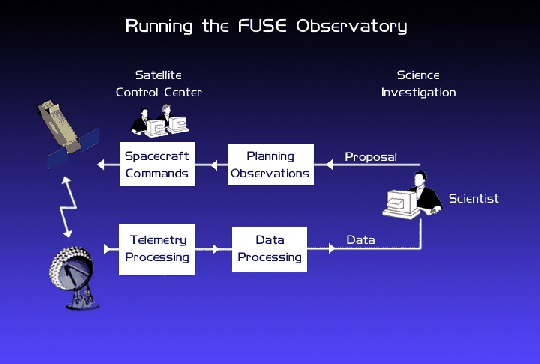

Mission Status Report #32 Star Date: March 30, 2000 The FUSE Science Center and FUSE Satellite Control Center at JHU handle all of the planning, scheduling and operations aspects of the FUSE mission, all from within an academic department within the Physics and Astronomy Department at the Johns Hopkins University.
(Click image to see larger version.)
FUSE Observatory in Full SwingIt's been a month since my last report, but the news is good. The FUSE Observatory is operating nominally in all regards and obtaining science data on a wide variety of science projects for both the Principal Investigator team scientists, and also many of the Cycle 1 Guest Investigators selected by NASA. Numerous aspects of science operations have matured over the last month. For instance, our ability to plan observations to minimize channel misalignments (refer to Mission Status Report #24 for details) and our ability ability to take pre-emptive actions to keep the channels aligned as we move from one target to the next, have combined to provide much improved data sets coming from the satellite. Several important calibrations are in place now, and the data "pipeline" that processes FUSE data into a form usable by the scientists has also matured. A recalibration of the gyroscopes and Two-axis Magnetometers has resulted in an improved slew accuracy, making it possible to move larger angles between targets and still have confidence in target acquisitions. On the science side, the FUSE Science Team has submitted a batch of 21 papers for publication as a special issue of the Astrophysical Journal Letters, a technical journal. These results are primarily based on so-called Early Release Observations, and many more results are coming along behind these initial reports. One recent set of observations were performed on a "dwarf nova" that went into outburst, with support being provided to the guest investigator AND the FUSE planning team by the American Association of Variable Star Observers (AAVSO). While the time-critical nature of the observations pushed our planning abilities toward their limits, the resulting data set provides a unique look into the outbursts of these mass-transferring binary star systems. Even as the "flow" of Cycle 1 progresses, we are preparing for a new round of proposal requests from the astronomical community. NASA will soon be releasing a research announcement about this round of proposals, and we are working to prepare all of the support materials and documentation for this effort. As the chart above indicates, we do it all right here at JHU!
Reported by: Bill Blair, Chief of Mission Planning
|
